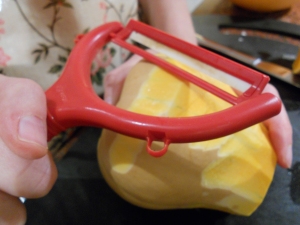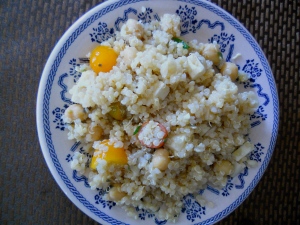My mother swears that the only thing I ate until the age of 12 was broccoli. Sylvie agrees, and a family friend once reminisced about my being in a high chair, too young to form full sentences, but making my points using fistfuls of broccoli. Well, Lilli is a bit like her mom in that regards. She is a broccoli fiend. It’s very cute to watch because she eats it upside down: She holds the floret in her fist and starts at the stalk. I keep on trying to explain to her that the stalk is the perfect handle, but she seems very set in her ways for now. Hey, she only learned her name about a month and a half ago. Baby steps.
I’ve only served it to her roasted, which, in my humble, broccoli loving opinion, is the yummiest way to eat the vegetable. When you roast it, bits of the shrub brown and caramelize and taste almost candy-like. Sylvie was in Seattle last January, and something called blasted broccoli had become very chic in the city. That, and Macklemore. I kind of can’t believe I just wrote that there’s a hot new broccoli dish around, but I did. I poked around online and gave blasted broccoli a shot. It was good, but unnecessary. All you need is a sprinkling of kosher salt, some olive oil, and a hot, hot oven.
I mention my broccoli love well into the third year of writing this blog, because there is a farro and roasted broccoli salad that I make pretty constantly. For me, it’s a bit of a little black dress recipe: Something that’s totally reliable and always tastes good. It’s so the norm in my kitchen that I’ve never bothered to mention it, but, it’s been a weeknight staple in our house for a long time. Roasting broccoli takes about 20 minutes, which is how long it takes to cook the farro in my pressure cooker.
When both are ready, I heat a pan with oil, add some minced garlic, break off about a tablespoon of tomato paste I keep on hand in the freezer, then add the farro and roasted broccoli and cook it all up for about five minutes. I’m not exactly sure where I came up with this method, but a few months back I was reading about the history of Israeli cous cous (extremely fascinating and worth the read) and I noticed that the tomato paste sauté is a popular way to serve the pasta in that country. I don’t remember learning that at any point, but perhaps it’s my Zionist leanings leading the inspiration.
Although I’ve read a few places online recently that you don’t have to soak your farro, I consistently do. I can’t risk having uncooked grains when we need to have dinner. I promise you, soaking grains is simple and not a big deal. Right before I go to bed, I pour a cup of farro into a bowl on my counter top, cover it with water, and walk away. That’s pretty much my go-to with all the grains and beans in my pantry. Except for lentils; those I know for certain don’t need any soaking. At some point, I’ll share a killer lentil soup recipe. Good freezer recipe, I might add. Speaking of freezers, farro, like most grains, freezes beautifully. I wouldn’t freeze this salad, but if you have extra farro in your fridge and worry you might not get to it, just pop it in the freezer. It defrosts like a dream.
Roasted Broccoli and Farro Salad
1 bunch roasted broccoli
Pinch of kosher salt
About a Tablespoon and a half of olive oil
1 cup dry farro
2 cloves minced garlic
1 Tablespoon tomato paste
Directions
Soak your farro the night before. See note above for more of an explanation why I insist on doing so.
Preheat oven to 400F.
When ready to cook, add the farro to your pressure cooker. Cover with water. I tend to add water until it’s a half an inch past the grain.– I always add a bit more water to the cooker than I might need to. I’d rather drain off water than scorch my pot. The farro will cook in 20 minutes once pressurized.
While the farro is roasting, clean your broccoli by giving it a good rinse, trimming the green leaves off the stalk, and cutting it into bite-sized pieces. I use my stalks too; just trim off the woody parts and it’ll be fine.
Cover a baking sheet with tinfoil. I do this first, a. because my hands are about to get oily because of the broccoli toss and b. so I don’t have to give the pan a good scrubbing in my kitchen clean up.
In a large bowl toss the broccoli with the kosher salt and enough olive oil to coat. Dump the broccoli onto the foil-covered baking sheet. Roast in the oven for 20 minutes.
While the broccoli roasts and the farro is cooking, mince up two garlic cloves.
When both are done cooking, and you’ve drained your farro in a colander in the sink, heat up a skillet with enough olive oil to coat the pan, and add the garlic and tomato paste. Because I always use frozen tomato paste, it really becomes a matter of melting the paste into the garlic and oil. Once the tomato paste has coated the garlic, add the farro and broccoli. The farro will turn an orangey hue. Add a pinch of kosher salt. Heat everything together so that it combines. This should take about five minutes. Serve and enjoy.
Last week I decided to add a little chile pepper to the tomato paste step. Good stuff if you have it on hand, but not necessary.






















